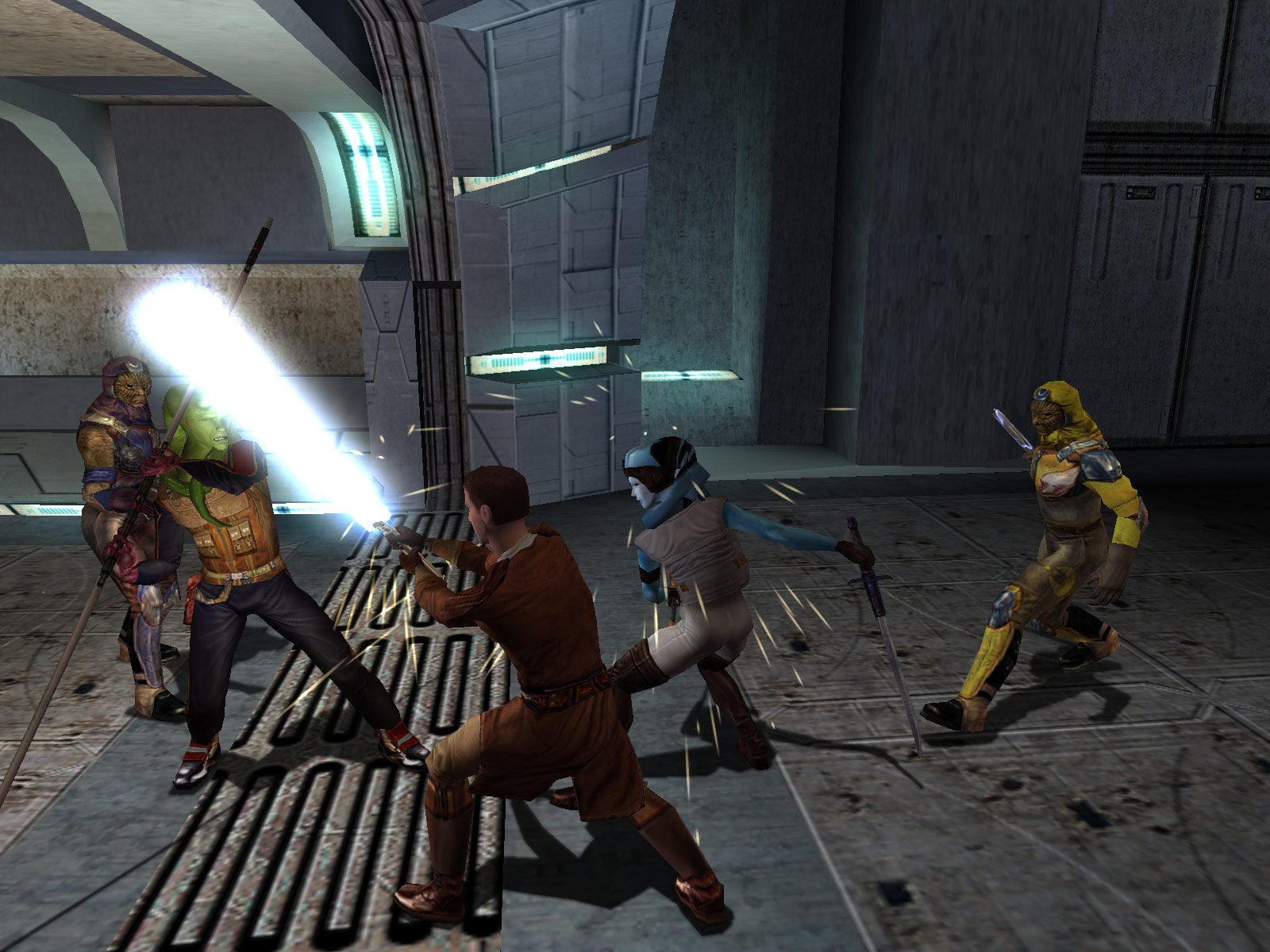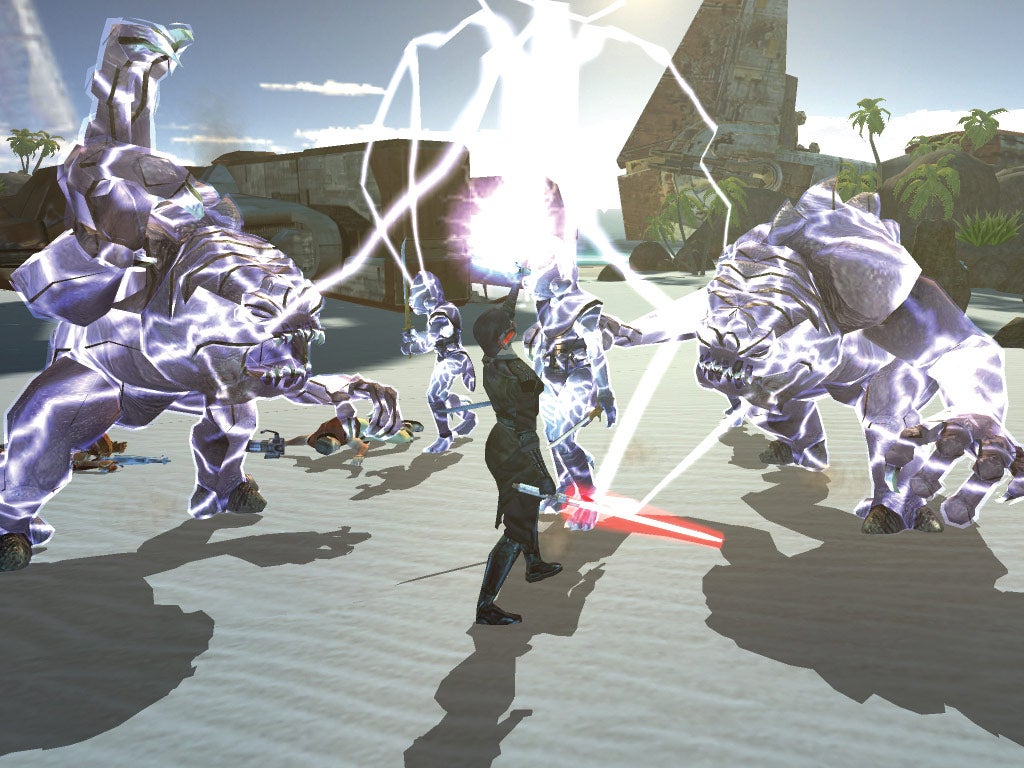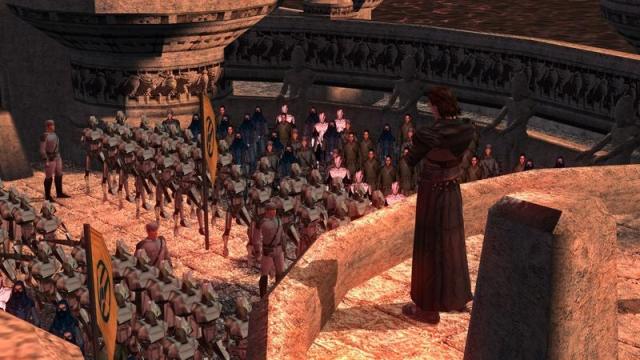If you rush through it, finishing Star Wars: Knights Of The Old Republic takes just about the same amount of time as watching all six existing Star Wars movies.
Even though it’s set a few thousand years before Anakin Skywalker has to inexplicably race a pod while enduring the squeals of Two-Headed Greg Proops, it still runs through many of the same motions as the movies. There’s the Jedi training montage with a frog man. Surviving your space adventure requires the help of a Wookiee with a life debt to a thief, a small robot that beeps, and a tall comic-relief robot. There are thrilling spaceship escapes from planets patrolled by bad soldiers in shiny helmets, shady deals with grotesque slug mobsters, and even races in dangerous hovering vehicles. All of it’s set against the backdrop of a power struggle between good and evil, Jedi against Sith, with you smack in the middle.
Thanks to its unusual exploration of that war between light and dark, though, it ends in a dramatically different place than the Star Wars movies. Play to the end, and it makes a bold, unexpected statement: Being good is dumb. Evil is much more fun, says the ending of Knights Of The Old Republic, the rare game whose alternate conclusions demonstrate that the “right” decision isn’t the one you’ll necessarily enjoy the most.

While you’re not a teenage moisture farmer or a strangely healthy slave boy, KOTOR does place you in the role of a seemingly innocent bystander caught up in the struggle between light and dark. Later, naturally, you’re revealed to be a powerful Force vessel, but at the start, you’re just a hapless amnesiac waking up on a Republic ship besieged by a Darth Malak’s Sith fleet. Carth, the game’s white-bread soldier type, gets you caught up on your way to save Jedi heroine Bastilla. When the three of you escape the ship, thus begins your journey to punch Malak right in his funky jaw box, stop the Sith from ruling the galaxy, and inevitably find yourself becoming the most potent user of the Force around. Whether you become a Jedi or a Sith Lord is up to you, though.
In its signature style, BioWare built Knights Of The Old Republic around a cavalcade of binary choices, letting you decide what kind of Force user you want to be: a patient, noble Jedi or an inveterate dick of a Sith. No series in BioWare’s catalogue has been more tailormade for this sort of dichotomy. Unlike Mass Effect or Dragon Age, the very make up of reality in Star Wars is fuelled by a tug of war between forces of good and evil. The choices that define whether you’re a Jedi or Sith in KOTOR are also laughably lacking in subtlety. Take your crew’s visit to Tatooine. Tusken Raiders are hassling the locals and you need a hunting licence to find a piece of ancient star map that leads to Malak’s secret base, the legendary Star Forge. Options for dealing with the brutes include: head out with HK-47 — the murder droid you can buy in town — and have him grudgingly act as translator for a diplomatic piece with the sand people, or kill some sand people and wear their robes so you can sneak into the village and finish off the rest.
That’s representative of most of the choices you run into in the game. Do you find a way to chase off the enormous fish monster blocking your path on the ocean planet of Manaan, or do you kill it? Should you help the Wookiees of Kashyyyk escape the evil Sith slavers or, you know, kill the slavers and the Wookiees and everything else between you and your destination in the jungle? Given that the journey down the Dark Side seems so utterly simplistic, it would be reasonable to think that the more nuanced, complex approach of the light would ultimately be more engaging as both a game and story. But it’s not. Invariably the evil path is the more colourful in Knights Of The Old Republic.

That bias bears out in both character and action. Your character’s allegiance to either light or dark determines their Force-powered abilities, and the evil skills prove much more useful in bringing down enemies. If you follow the light path, you’re given high-level skills for destroying droids and creating whirlwinds that incapacitate foes. That’s all well and good, but popping cartoon robots and pushing around bad guys is about as thrilling here as it was when Hayden Christensen and Ewan McGregor sleepwalked their way through doing the same in Revenge Of The Sith. It’s more entertaining to walk into a room full of bounty hunters, cast Sith Horror to make them all freak out, and then electrocute the lot of them. HK-47, the acerbic assassin droid who’s always eager to kill “meatbags,” is a whole lot more fun to have in your party than the utterly bland Carth Onasi.
Still, all of KOTOR’s good and evil divergences pale in comparison to the difference between its endings. Once you’ve fought your way to Malak’s Star Forge, you’re given the final choice: Destroy the technology to build an infinite, unstoppable fleet of war machines, or take it on for yourself. If you do what seems like the right thing — and terrorizing the galaxy with an unstoppable war fleet seems pretty wrong — then you’re treated to a brief, utterly dissatisfying awards ceremony on the uncharted planet that the Star Forge orbits. There’s your party, all lined up in a row on a stage with Fake Yoda and the other Jedi while a fanfare plays, just like the ending of the original 1977 movie. The scene feels a whole lot more like the parade at the end of The Phantom Menace, though. Nothing feels resolved and there’s no real meaningful road forward for any of these characters.
The evil ending, KOTOR’s sweetest plum, offers so much more, including a satisfying conclusion to the twist that kicks off the game’s second act. Long before you reach the Star Forge, you find out that your character isn’t just some talented guy or gal with a concussion. All along, you were playing as Darth Revan, Malak’s legendary lost master who, it turns out, was captured and brainwashed by the Jedi to see if his gifts could be used for good. The final battle finds you fully embracing your past, unlocking your sealed power, and reasserting control of both Malak and the Star Forge itself. The Jedi and the Republic realise their mistake in attempting to manipulate someone to their own ends, and the good guys signal a massive retreat. Before the credits role, you step out as Revan in front of your new army under a blood red sky, the galaxy at your mercy.
On the surface, the Sith ending is exciting because it’s so different than what we’ve seen elsewhere in Star Wars. We’ve never really witnessed evil triumph as a conclusion, at least not on this scale. Darth Vader moaning, “Nooo!” and then staring out a window next to a guy doing Grand Moff Tarkin cosplay doesn’t really compare. It’s also so much more dynamic than the lame awards ceremony in the “good” ending. Ending any story by saying, “No one important got hurt! Medals for everyone! Huzzah!” is always boring. When it happens in A New Hope, it feels like a necessary bolstering of morale before the real war against the empire begins. Here, it’s pap.
Dig deeper, though, and the Sith ending reveals that Knights Of The Old Republic is better at exploring the internal struggle between good and evil than the movies ever were. Anakin Skywalker’s turn to the dark side is flaccid and disappointing in Revenge Of The Sith. Some anxiety dreams about your wife dying in labour made you turn into Space Hitler? Really, man? Meanwhile, Luke Skywalker’s journey finds him scarcely tempted. What does the dark side have for him? A chance to work out some daddy issues is pretty much it, and he gets most of that catharsis by having a stilted conversation with his pop on board the Death Star and getting his hand cut off. Palpatine never had a chance with Luke because he never had anything to offer him.
The ending of Knights Of The Old Republic is the ultimate reward for embracing the ease and pleasure of unlimited power. The whole game tempts you with funnier characters and more succulent skills to wield in battle, then ultimately tells you that giving into that temptation is at least in part justified. The Jedi kidnapped you and destroyed your mind! That’s not very virtuous, so how good are the Jedi, really? Can’t you do better than everyone else?
When you answer yes to that question in KOTOR, you are rewarded with a more satisfying, nuanced finale. Darth Revan reclaims his mantle, and rather than medals for everyone, there’s a rich implied future as he takes over, which is what the very best Star Wars creations always do. The series sings when it implies that there’s more going on than what you see, more story still to tell. BioWare’s dark-side ending is where the story goes on, rather than finishing flat on a podium as everyone stands around looking dumbly pleased with themselves.

Comments